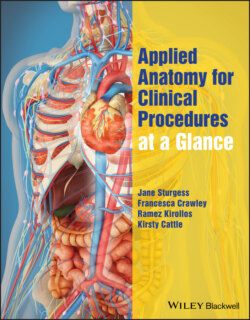Читать книгу Applied Anatomy for Clinical Procedures at a Glance - Jane Sturgess - Страница 9
Оглавление1 Scrubbing up
Sherif Kirollos and Ramez Kirollos
Figure 1.1 Equipment.
Figure 1.2 Before scrubbing, don hat, mask, eye protection.
Figure 1.3 Recommended handwashing technique.
Figure 1.4 Procedure. (a) Wash hands and arms three times (b) rinsing from fingertips to elbows between each wash. (c) Dry skin thoroughly, from hands down to elbows. (d) Don gown and gloves touching only the inside of each.
Equipment (Figure 1.1)
Antiseptic solution [either povidone iodine (Betadine) or chlorhexidine]
Gown
Gloves
Face mask
Nail brush
Antiseptic solutions
The common antiseptics used for scrubbing are povidone iodine (Betadine) and chlorhexidine. These are applied to the skin and have a bactericidal or bacteriostatic effect, but complete asepsis (sterility) is not achieved.
Chlorhexidine: This is a cationic polybiguanide which achieves both a bacteriostatic and bactericidal effect depending on its concentration, through the release of charged cations which bind to and disrupt the bacterial cell wall. This solution is effective against a broad range of organisms, including gram‐positive and gram‐negative organisms, aerobes, anaerobes, and yeasts.
Povidone iodine: This is a solution containing a combination of iodine and polyvinylpyrrolidone (PVP). A bactericidal effect is achieved through the molecular iodine, and PVP acts as an iodophor to prevent irritation and toxicity to the tissue by keeping the free iodine concentration low. The solution acts against gram‐positive and gram‐negative bacteria, bacterial spores, viruses, protozoa, and fungi.
Procedure (Figure 1.4)
1 The hair is first covered by a hat and a mask is worn. Depending on the procedure protective eye goggles may be used. For specific procedures, a hooded surgical gown can be used (Figure 1.2).
2 For the first scrubbing in of the day, handwashing should last for 5 minutes, and subsequent handwashing should allow 3 minutes each, following the recommended handwashing procedure (Figure 1.3).
3 Any breach of the procedure requires recommencing of the cycle.
4 Antiseptic washing must cover all aspects of the skin of the hands and forearms, extending to the elbows. Particular attention should be paid to the interdigital spaces and under the nails. A brush may be used to apply the antiseptic solution to the skin under the nails but is best avoided elsewhere to avoid causing superficial skin abrasions with more vigorous scrubbing as that would expose underlying cutaneous bacteria.
5 During handwashing, ensure that hands and forearms remain elevated, allowing the water to drip from the elbow to avoid contamination as a result of water running from unsterile regions to areas already cleaned. Shaking should also be avoided for the same reason.
6 Throughout the handwashing cycles, ensure enough time is allowed for contact of the antiseptic with the skin before running it under water.
7 The skin is then dried with sterile towels while avoiding contact with unsterile regions (Figure 1.4c).
8 As contact with non‐sterile surroundings is prevented, the gown is then delivered from its sterile wrapping and donned (Figure 1.4d).
9 The arms and hands are kept within the sleeves until gloves are worn without touching their outer surface. This can be achieved by initially avoiding protruding the fingers through the gown sleeves. Alternatively, the surgeon is helped by an assistant or a scrub nurse holding open each pair of gloves.
